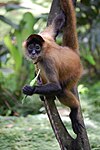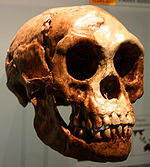Portal:Primates
The Primates Portal A primate is a member of the biological order Primates, the group that contains lemurs, the aye-aye, lorisids, galagos, tarsiers, monkeys, and apes, with the last category including great apes. With the exception of humans, who inhabit every continent on Earth, most primates live in tropical or subtropical regions of the Americas, Africa and Asia. Primates range in size from the 30-gram (1 oz) pygmy mouse lemur to the 200-kilogram (440 lb) mountain gorilla. According to fossil evidence, the primitive ancestors of primates may have existed in the late Cretaceous period around 65 mya (million years ago), and the oldest known primate is the Late Paleocene Plesiadapis, c. 55–58 mya. Molecular clock studies suggest that the primate branch may be even older, originating in the mid-Cretaceous period around 85 mya. Primates exhibit a wide range of characteristics. Some primates do not live primarily in trees, but all species possess adaptations for climbing trees. Locomotion techniques used include leaping from tree to tree, walking on two or four limbs, knuckle-walking, and swinging between branches of trees (known as brachiation). Primates are characterized by their large brains relative to other mammals. These features are most significant in monkeys and apes, and noticeably less so in lorises and lemurs. Many species are sexually dimorphic, which means males and females have different physical traits, including body mass, canine tooth size, and coloration.
Selected article
Lemurs are strepsirrhine primates, all species of which are endemic to Madagascar. They include the smallest primate in the world, Madame Berthe's mouse lemur, which weighs 30 grams (1.1 oz), and range up to the size of the indri, which can weigh as much as 9.5 kilograms (21 lb). However, recently extinct species grew much larger. As of 2008, 5 families, 15 genera, and 99 species and subspecies of lemur are formally recognized. Of the 99 species and subspecies, the International Union for Conservation of Nature (IUCN) has classified 8 as Critically Endangered, 18 as Endangered, 14 as Vulnerable, 5 as Near Threatened, 8 as Least Concern, 43 as Data Deficient, and 3 have yet to be evaluated. From 2000 through 2008, 39 new species were described and 9 other taxa resurrected.
The number of lemur species is likely to continue growing in the coming years, as field studies, cytogenetic and molecular genetic research continues. There is not complete agreement over the latest revisions to lemur taxonomy, and the debates are likely to continue. In many cases, classifications will ultimately depend upon which species concept is used. In the case of the lemurs of Madagascar, which have suffered extensively from deforestation and habitat fragmentation, nearly 25% of all species are either Endangered or Critically Endangered, most have yet to be extensively studied, and nearly all populations are in decline. For these reasons, taxonomists and conservationists favor splitting them into separate species to develop an effective strategy for the conservation of the full range of lemur diversity. Implicitly, this means that full species status will help grant genetically distinct populations added environmental protection. Selected picture The ring-tailed lemur (Lemur catta) is a large strepsirrhine primate and the most recognized lemur due to its long, black and white ringed tail. It belongs to Lemuridae, one of five lemur families, and is the only member of the Lemur genus. Like all lemurs it is endemic to the island of Madagascar. Known locally in Malagasy as maky (spelled maki in French) or hira, it inhabits gallery forests to spiny scrub in the southern regions of the island. It is omnivorous and the most terrestrial of lemurs. The animal is diurnal, being active exclusively in daylight hours. CategoriesSelected species Extinct (IUCN 3.1)|Extinct Homo floresiensis ( /flɔːrˈɛziːˌɛn.sɪs/ also known as "Flores Man") is an extinct species of small archaic human that inhabited the island of Flores, Indonesia, until the arrival of modern humans about 50,000 years ago. The remains of an individual who would have stood about 1.1 m (3 ft 7 in) in height were discovered in 2003 at Liang Bua cave. Partial skeletons of at least nine individuals have been recovered, including one complete skull, referred to as "LB1". (Full article...) Did you know?
Primate lists
WikiProjectsThings to do
Associated WikimediaDiscover Wikipedia using portals |
- Portals with triaged subpages from February 2020
- All portals with triaged subpages
- All portals
- Portals with no named maintainer
- Random portal component with 31–40 available subpages
- Random portal component with 6–10 available image subpages
- Random portal component with 26–30 available subpages
- Random portal component with 2–5 available subpages
- Primates
- Animal portals
















